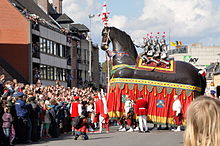
The Grand-Place or Grote Markt is the central square of Brussels, Belgium. It is surrounded by opulent Baroque guildhalls of the former Guilds of Brussels and two larger edifices; the city's Flamboyant Town Hall, and the neo-Gothic King's House or Bread House building, containing the Brussels City Museum. The square measures 68 by 110 metres and is entirely paved.

Belgian culture involves both the aspects shared by all Belgians regardless of the language they speak and the differences between the main cultural communities: the Dutch-speaking Belgians (Flemish) and the French-speaking Belgians. Most Belgians view their culture as an integral part of European culture.

Dendermonde is a city in the Flemish province of East Flanders in Belgium. The municipality comprises the city of Dendermonde and the towns of Appels, Baasrode, Grembergen, Mespelare, Oudegem, Schoonaarde, and Sint-Gillis-bij-Dendermonde. Dendermonde is at the mouth of the river Dender, where it flows into the Scheldt. The town has a long-standing folkloric feud with Aalst, south along the same river, which dates from the Middle Ages.
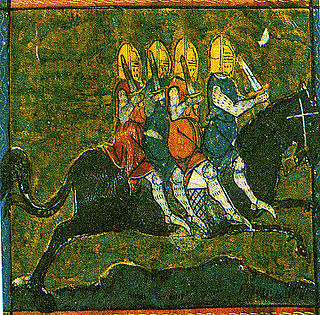
Bayard is a magical bay horse in the legends derived from the medieval chansons de geste. These texts, especially that of The Four Sons of Aymon, attribute to him magical qualities and a supernatural origin. He is known for his strength and intelligence, and possesses the supernatural ability to adjust his size to his riders.

Processional giants are costumed figures in European folklore, particularly present in Belgian, French, Portuguese, Spanish, and English folkloric processions. The main feature of these figures is typically their wooden, papier maché or -more recently- synthetic resin head, whilst bodies are covered in clothing matching the costume's theme.

A medieval pageant is a form of procession traditionally associated with both secular and religious rituals, often with a narrative structure. Pageantry was an important aspect of medieval European seasonal festivals, in particular around the celebration of Corpus Christi, which began after the thirteenth century. This festival reenacted the entire history of the world, in processional performance, from Bible's Genesis to the Apocalypse, employing hundreds of performers and mobile scenic elements. Plays were performed on mobile stages, called waggons, that traveled through towns so plays could be watched consecutively. Each waggon was sponsored by a guild who wrote, designed, and acted in the plays.

The Procession of the Holy Blood is a large religious Catholic procession, dating back to the Middle Ages, which takes place each Ascension Day in Bruges, Belgium. In 2009, it was included in the UNESCO Representative List of the Intangible Cultural Heritage of Humanity.

Ommegang or Ommeganck is the generic name for various medieval pageants celebrated in the Low Countries.

The Ducasse de Mons, also commonly known as the Doudou, is a traditional folk festival held in Mons, Hainaut, Belgium, on Trinity Sunday. The feast comprises two important parts: the procession, including the descent and the uprising of the Saint Waltrude's shrine, as well as the combat named Lumeçon between Saint George and a dragon. Since 2008, it is recognised as a Masterpiece of the Oral and Intangible Heritage of Humanity by UNESCO.

Bloemencorso means "flower parade", "flower pageant" or "flower procession". In a parade of this kind the floats (praalwagens), cars and boats are magnificently decorated or covered in flowers. This custom goes back as far as the Middle Ages. Each parade has its own character, charm and theme. Many towns and regions in the Netherlands and Belgium hold parades every year.

Pieter Franciscus Dierckx was a Belgian impressionist painter.

The Four Sons of Aymon, sometimes also referred to as Renaud de Montauban is a medieval tale spun around the four sons of Duke Aymon: the knight Renaud de Montauban, his brothers Guichard, Allard and Richardet, their magical horse Bayard, their adventures and revolt against the emperor Charlemagne. The story had a European success and echoes of the story are still found today in certain folklore traditions.
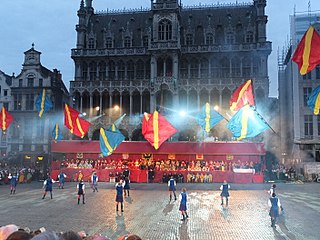
The Ommegang of Brussels is a traditional Ommegang, a type of medieval pageant, celebrated annually in Brussels, Belgium.

Appels is a town in the Flemish province of East Flanders in Belgium. It is part of the municipality Dendermonde.
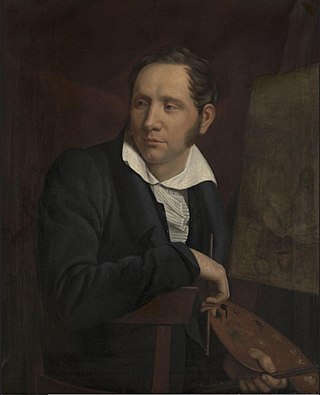
Jozef Geirnaert, also known as Jozef Lodewijk Geirnaert, Théodore-Joseph-Louis Geirnaert and Joseph Louis Geirnaert, was a 19th-century painter and draughtsman from Belgium. He is known for his genre scenes, portraits as well as his historical, religious and mythological paintings. He was first influenced by the Neoclassical style of Jacques-Louis David and later by the version of Romanticism that was in vogue in Belgium from the 1830s.
The Folklore of Belgium is extremely diverse and reflects the rich legacy of cultural and religious influences which have acted on the region throughout its history, even before the establishment of the nation of Belgium in 1830. Much of Belgian folklore is unique to the region in which it is commemorated. Many aspects of folklore are manifested in public processions and parades in Belgian cities; traditions which are kept alive for the amusement of locals and tourists alike.
Aloïs De Beule was a Belgian sculptor.

The processional giants and dragons of Belgium and France are a set of folkloric manifestations involving processional giants, which have been inscribed by UNESCO on the lists of Intangible Cultural Heritage in 2008, originally proclaimed in November 2005.

The Ducasse d'Ath is a traditional folk festival held in Ath, Hainaut, Belgium, to mark the victory of David over Goliath. The parade is held annually on the fourth Sunday of August and is characterised by the presence of processional giants depicting the horse Bayard and several other characters from local history. From 2008 to 2022, it was recognised as a Masterpiece of the Oral and Intangible Heritage of Humanity by UNESCO.
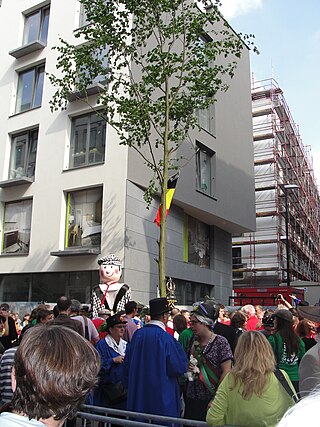
The Meyboom plantation is the oldest tradition in Brussels, Belgium, attested since 1308. It is held every year on 9 August, the eve of St Lawrence's Day, and consists mainly in planting a beech at the intersection of the Rue des Sables/Zandstraat and the Rue du Marais/Broekstraat in the City of Brussels' Marais–Jacqmain District. It is accompanied by processions and various folk activities during the day.


